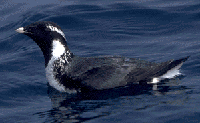- Synthliboramphus
Taxobox
name = " Synthliboramphus "

image_width = 250px
image_caption = Ancient Murrelet
regnum =Animal ia
phylum =Chordata
classis = Aves
ordo =Charadriiformes
familia =Alcidae
genus = " Synthliboramphus "
genus_authority = Brandt,1837
subdivision_ranks = Species
subdivision = " S. hypoleucus"
" S. craveri"
" S.antiquus"
" S. wumizusume"
synonyms ="Endomychura""Synthliboramphus" is a small genus of
seabird s in theauk family from theNorth Pacific . It consists of four species:
*Xantus's Murrelet , "Synthliboramphus hypoleucus"
*Craveri's Murrelet , " Synthliboramphus craveri"
*Ancient Murrelet , " Synthliboramphus antiquus"
*Japanese Murrelet , " Synthliboramphus wumizusume"The first two species were formally consideredconspecific , and are sometimes separated in the genus "Endomychura".Fossil remains of two prehistoric species are known: an undescribed "Synthliboramphus" sp. from the Late Miocene or Early Pliocene (c. 5 mya) ofCedros Island ,Mexico , and "Synthliboramphus rineyi" from theLate Pliocene (around 3.5-2 mya)San Diego Formation of the southwestern USA.These birds breed in colonies, their eggs being laid directly amongst tree roots or in rock crevices. They are nocturnal on the breeding grounds, presumably to reduce predation, and for the same reason the
precocial young are never fed at the nest, being taken to sea a couple of days after hatching. The parents call to the young from out at sea, and the chicks swim towards the adults who keep moving further out throughout the night."Synthliboramphus" species disperse out to sea after breeding, with northern species migrating further south.
"Synthliboramphus" auks are small, with mainly black upper parts and white the short wings. These birds forage for food like other auks, by swimming underwater. They mainly eat
fish , also somecrustacean s and other smallinvertebrate s.References
*
National Geographic Society (2002): "Field Guide to the Birds of North America". National Geographic, Washington DC. ISBN 0-792-26877-6
Wikimedia Foundation. 2010.
